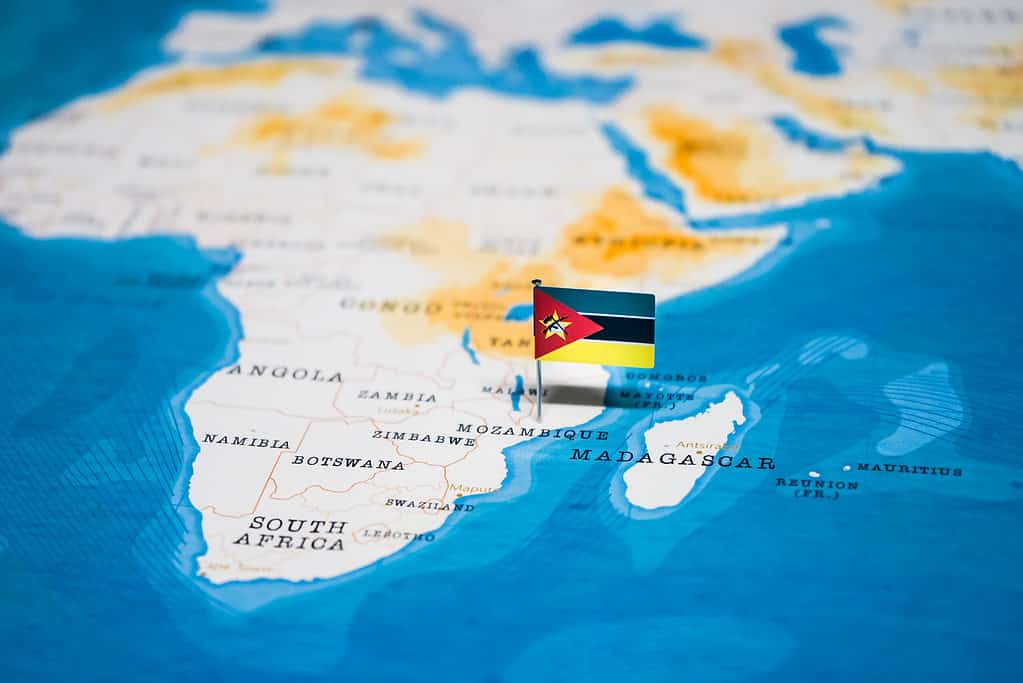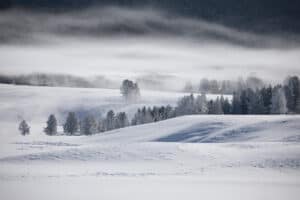Where is Mozambique?

Mozambique is located on Africa’s southeast coast.
©Hyotographics/Shutterstock.com
Mozambique is a country located in southeastern Africa, sharing borders with Tanzania, Malawi, Zambia, Zimbabwe, South Africa, and Swaziland. It has a population of approximately 31.6 million people and covers an area of 801,590 square kilometers. In the paragraphs below, we will discuss many interesting facts about the country, including the flag of Mozambique.
Mozambique: Languages and Religions
The official languages of Mozambique are Portuguese and Emakhuwa; other languages spoken in the country include Makhuwa, Sena, Ndau, and Cisena.
Religion plays an important role in the culture of Mozambique. The largest religious group is Christianity, followed by Islam and traditional African beliefs. Christianity has been present in the country since the 15th century when Portuguese explorers first arrived. The Makonde people who live in the northern part of the country practice Islam, while some rural populations practice traditional African beliefs.
Mozambique: Cuisine and Culture
Mozambican is a blend of various African cultures, as well as Portuguese and Indian influences. Music in Mozambique is diverse, with traditional rhythms such as marrabenta and makwaya being popular. The cuisine of Mozambique reflects the country’s cultural diversity; it has strong Portuguese and Indian influences but also includes many African staples like cassava, cornmeal porridge (xima), peanuts (munguba), fish dishes, coconut milk-based stews (matapa) and spicy curries.
Arts are an important part of Mozambican culture; daily life or political events often inspire paintings, while historical figures or everyday objects inspire sculptures. Art forms, such as basket weaving and carving wooden masks for traditional ceremonies, have been around for generations. Despite its recent history of colonialism and civil war, the people of Mozambique remain resilient; they strive to keep their traditions alive while adapting to a changing world.
Mozambique: Geography and Climate
Mozambique is a country located in southeastern Africa, bordered by Tanzania to the north, Zambia and Malawi to the northwest, Zimbabwe to the west, and South Africa and Swaziland to the southwest. It also sits by the Mozambique Channel of the Indian Ocean. The country has a total area of 309,495 square miles.
The climate in Mozambique varies, but is tropical in most areas, with average temperatures ranging between 68-86°F. There are two distinct seasons: wet season (Oct-Mar) and dry season (Apr-Sep), which vary depending on where you are; the northern parts tend to have slightly higher rainfall than southern regions. Generally speaking, there is high humidity along coastal regions throughout much of the year, with some relief during dry season months when winds blow inward from the ocean.
Mozambique: Political History
Mozambique has a rich history which includes its founding in the 15th century by Arab traders. Exploring the pre-colonial era of Mozambique reveals that it was made up of numerous small kingdoms and cultures which developed independently over time. After centuries of colonial rule by Portugal, Mozambique gained independence in 1975 following a 10-year war. Since then, Mozambique has experienced several political developments, including the Civil War of 1977-1992 and the Frelimo-Renamo Peace Accord of 1992. In recent years, the country has seen significant economic growth and development due to foreign investment and improved relations with neighboring countries.
Mozambique’s political system is a multi-party democracy led by President Filipe Nyusi and Prime Minister Carlos Agostinho do Rosario. The major political parties are the Mozambique Liberation Front (FRELIMO), the Mozambican National Resistance (RENAMO), and the Democratic Movement of Mozambique (MDM).
Flag of Mozambique: Description

The Mozambique flag features a yellow five-point star with an open book in the middle.
©Steve Allen/Shutterstock.com
The flag of Mozambique has been in place since 1983. It consists of three horizontal stripes of equal size. The top stripe is a rich teal color with a thin white lining at the bottom. The middle stripe is black, also with a white line underneath. The bottom stripe is yellow. At the left of the flag is a bold red triangle pointing to the center. Inside the red area is a yellow five-point star with an open book in the middle. Superimposed over the star and book is a depiction of a Kalashnikov rifle and bayonet crisscrossed with a gardening hoe.
The Flag of Mozambique: Symbolism
The color teal stands for the riches of the land. The white trim above and below the black stripe stands for peace. The color black represents the continent of Africa. Yellow is a symbol of the country’s minerals. The red triangle stands for the struggle to gain independence. The rifle represents defense and vigilance. The open book is a symbol of the importance of education. The gardening hoe stands for rich agricultural lands. The yellow five-point star stands for the solidarity of the people of Mozambique.
Independence Day in Mozambique
Citizens celebrate Independence Day in Mozambique annually on June 25th. This day marks the nation’s independence from Portugal, which was declared in 1975 after a protracted struggle for freedom. The event features parades and other festivities that include traditional dances, music, food, and fireworks displays. During the celebrations, people will often wear colorful clothes adorned with the national flag of Mozambique to show their pride in their culture and history. Additionally, leaders of the country make speeches to honor past heroes, as well as inspire citizens to strive towards a better future.
Heroes’ Day in Mozambique
Heroes’ Day in Mozambique is a national holiday celebrated every 3rd of February. It commemorates the heroic struggle of the people of Mozambique against Portuguese colonial rule, which lasted for almost five centuries until 1975. The day also honors those who fought and gave their lives during this period. During Heroes’ Day, many ceremonies and events, such as parades, speeches by government officials, and military displays honor the heroes of Mozambique.
In addition to these activities, families gather together to remember their loved ones who fought in wars or sacrificed themselves for independence. On Heroes’ Day, it is customary for Mozambicans to express gratitude towards their freedom fighters and remember them with respect and admiration.
Previous Flags of Mozambique
1974-1975 During this time, the flag consisted of three horizontal stripes, bright green, black, and yellow. The black stripe is lined by a thin white filament. To the left is a triangle of red, pointing toward the center. It is very similar to the current flag but without the emblem inside the red triangle.
1975-1983 This flag consists of four stripes radiating outward from the top lefthand corner. They start out thin at the top and widen as they go toward the bottom right corner, like rays of the sun. The stripes are green, red, black, and yellow. At the top left corner is a white circle with a cerated edge. Inside the circle, sits a gun crossing a gardening hoe, superimposed over an open book. There is a tiny red five-point star above the book.
1983-1983 April to May – The horizontal green, black, and yellow stripes are shown, with a red triangle to the left, pointing toward the middle of the flag. Inside the red area is a yellow five-point star. Superimposed over the star is a white circle with a serrated edge. Inside the white circle is a gun and gardening hoe, lying in a crisscross fashion over the top of an open book. Above the book, sits a tiny red five-point star.
Similar Flags
The flag of Mozambique is not the only one to feature green, black, and yellow horizontal stripes. Many other countries have flags with similar designs, although they may differ in terms of size or shade. Examples of these countries include Angola, Ethiopia, Guinea-Bissau, Benin, and Togo. Despite the similarities between their flags, each nation has its own unique symbolism, which reflects their individual histories and cultures.
NEXT UP…
- The Flag of Cuba: History, Meaning, and Symbolism
- The Flag of the United States of America: History, Meaning, and Symbolism
- The Flag of Mexico: History, Meaning, and Symbolism
The photo featured at the top of this post is © Osman Bugra Nuvasil/Shutterstock.com
Sources
- T and F online, Available here: https://www.tandfonline.com/doi/abs/10.1080/01434639808666364
- Jstor.org, Available here: https://www.jstor.org/stable/4185517
- Papers.ssrn.com, Available here: https://papers.ssrn.com/sol3/papers.cfm?abstract_id=259490
- Scielo.org, Available here: http://www.scielo.org.za/scielo.php?script=sci_arttext&pid=S0259-01902013000100007
Thank you for reading! Have some feedback for us? Contact the AZ Animals editorial team.






